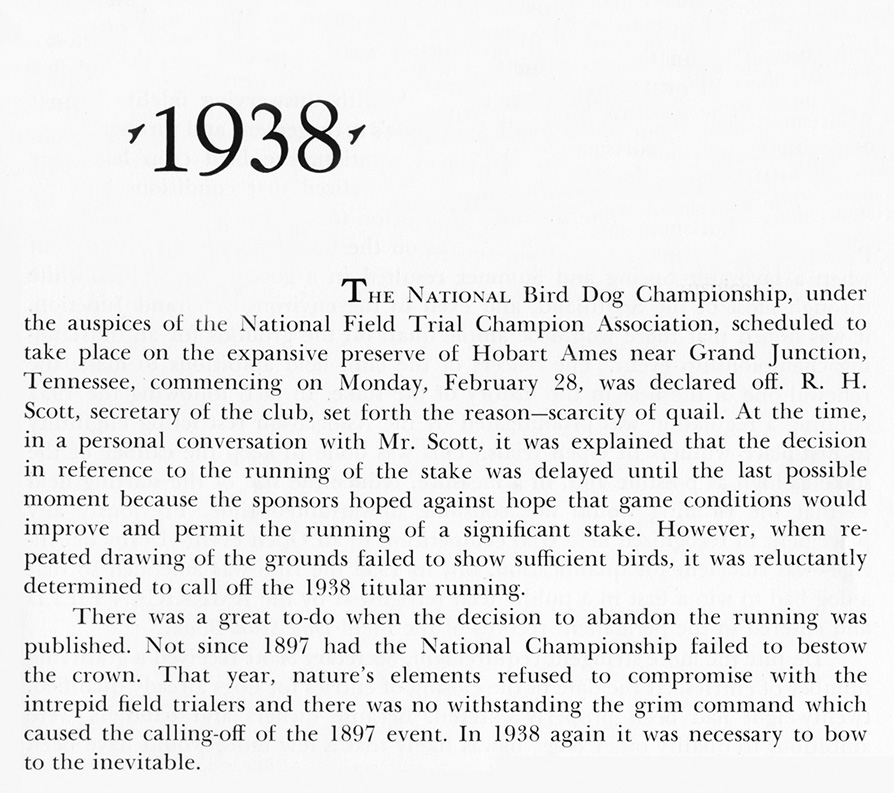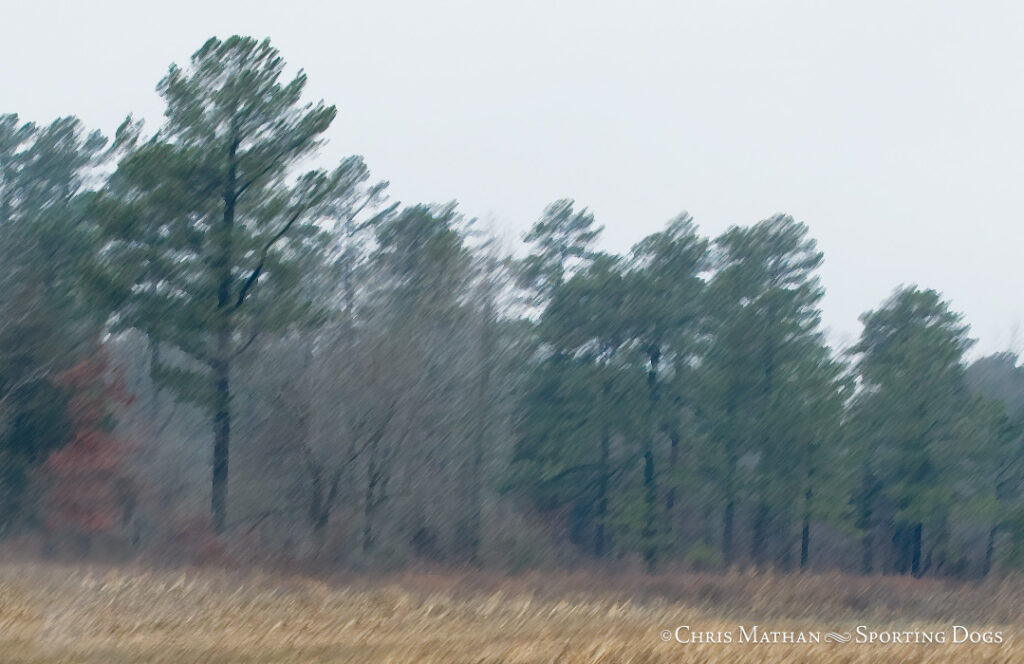The year was 1938. The place was the Ames Plantation at Grand Junction, Tennessee, 55 miles east of the Mississippi River at Memphis. The event was the National Bird Dog Championship. It had been held most years since 1896, and here since 1901. The subject of this story is the winning performance and the players in it, canine, equine and human.
The plantation was the 18,000 acre winter quail shooting playground and showplace farm of Hobart Ames of the Massachusetts Ames, a clan as prominent in industry and politics as existed in the Nation, indeed in the world. Its capital grew from two ironic sources: the manufacture of shovels since 1774, used to build the Nation’s railroads and by Forty-Niners to extract California’s gold discovered at Sutter’s Mill in 1848 and by the Union Army to entrench itself and quell the southern rebellion, 1861-1865; and the finance of the building of the transcontinental Union Pacific Railroad through Credit Mobilier of America, 1864-1867, a fraudulent enterprise headed by Hobart Ames’ grandfather, Massachusetts Congressman Oakes Ames, that bribed Congressmen with its stock, including Speaker of the House and U. S. Vice President under President Ulysses S. Grant, Schuyler Colfax. (The shovel business still thrives in 2022, and the Ames Plantation belongs to a foundation founded by Ames’ widow supporting the University of Tennessee, and still serves annually as grounds for the National Bird Dog Championship). The Ames family fortune serves as an example of the adage, “behind every great fortune lies a great crime” attributed to Balzac.
Hobart Ames served in 1938 as the senior of the trial’s three judges, as he had for many years. The other two were Dr. T. Benton King, a Tennessee medical doctor and frequent trial judge, and Nash Buckingham, popular outdoors magazine story-writer and professional hunting guest.
It was in the heart of the Great Depression, and the vast majority of the Nation’s citizens were suffering. Money was scarce and prices depressed, for few had any wealth. Average American income, $1,731; average new house, $3,900; new car, $860; gallon of gas, 10 cents.
Misery was rampant, except for the few with wealth or enough resources to get by and no debt. A farmer with his land paid for and an industrious wife could get by, growing and “putting up” food. City dwellers were less fortunate, unemployment was at 20%. The National population was 130 million.
How had field trials survived? Barely. Thirteen thousand ten bird dogs, including retrievers, were registered by the Field Dog Stud Book in 1938. About 223 recognized-by-the-FDSB pointing dog trials were held that year in the U. S. and Canada. This trial was to choose the best of the year’s pointing dogs. Its heats were three hours; twenty-eight dogs were entered, so it would require seven days running, two braces a day, and there was no running on Sundays. Weather delays often required more days.
In addition to quail hunting, the plantation supported Ames’ famous herd of Black Angus show cattle, a herd of show swine, and teams of show Percheron draft horses, all exhibited by Ames at the International Live Stock Exposition in Chicago. In 1913, Ames had built a magnificent brick 50-stall barn on the plantation to house his draft, harness and riding horses, a show barn if there ever were one.
In addition to other sporing interests, Ames wing shot internationally, driven grouse, partridge and pheasant in Scotland and England, ducks and geese at Swan Island Club on the Outer Banks in North Carolina as well as on Back Bay in his native Massachusetts. He fly cast for salmon in Canada and Scotland. He was truly a dead game sport, to use a term out of F. Scott Fitzgerald.
In those days field trial dogs were handled by two types of professionals: private trainers, employees of a single wealthy sponsor with a shooting plantation like Ames, and for-the-public trainers, who trained and handled dogs for several owners as independent contractors. Clyde Morton was the most prominent of the former. As an employee of A. G. C. Sage of New York and Alabama, heir to a timber fortune, he had in recent years dominated the National and other endurance stakes, including the National Free-For-All Championship, founded by Sage in 1919. Sage had been a director of the National Champion Association but grown unhappy with some of its policies, so founded its rival.
Morton’s nearest rival, now in his declining years, had been Chesley H. Harris, also based in Alabama, a towering World War One veteran who trained and handled for the public. Edward Farrior of Alabama was also a contender and his Air Pilot Sam a recent winner and sire of several Morton-Sage dogs. John Gates, now of Georgia, was coming on strong as a handler.
Three big differences distinguished the trials: the Free-for-All had no entrance requirements; its judges set a normal field-trial pace, faster than the National Championship which proceeded at a horseback hunt pace, much slower; and the Free-for-All had qualifying one-hour heats and three-hour finals heats.
Pundits said the Free-for-All crowned the continent’s top field trial-type dog and the National Championship the top hunting type. Both trials required a dog with unusual endurance, for few dogs could make a three-hour heat hunting before a horse. But Morton several times won both trials with the same dog, as did Harris and others.
Hobart Ames epitomized the ironic version of the Golden Rule: “Him with the gold, rules.” When he judged the National Championship he insisted the winner demonstrate perfect manners. Any breach of those manners disqualified an entry, in spite of its overall brilliance. This plays a part in our story.
When the last brace of the 1938 National Championship was about to be released, the three judges faced a daunting prospect: no entry so far had run a race Ames had not found disqualifying fault with. Nash Buckingham was beside himself. He had an invitation to hunt ducks on a favorite marsh in Arkansas starting tomorrow. He looked forward in dread to the prospect Ames would insist on a multi-dog call back in an effort to find a fault-free National Champion for 1938.
To the starting line for the final brace came Morton with a pointer named Beelzebub, qualified at the last minute by an obscure win of a new trial in Iowa. His bracemate was to be a dog handled by veteran Edward Farrior, but the night before, Farrior had scratched the dog, no reason given. So Beelzebub would go as a bye. As customary, he would be started with a plantation wagon dog which would be picked up after a brief effort.
None of the judges had seen Beelzebub before. He was a typical Sage-Morton type, fifty pounds, evenly marked liver ears and mask, one liver spot on his right rump, high tailed and overall handsome, a son of Air Pilot Sam.
“Let ‘em go,” barked Hobart Ames.
The bracemate was lifted at twenty minutes. Beelzebub was running a forward and well controlled race, typical of a Morton dog (Morton was known for staying in touch with his entries, knowing where they were at all times and vice versa). At two hours thirty minutes Beelzebub had scored three finds without a breach of manners and run enough to suit Ames who was not a fan of extreme range. Then it began to rain, and the rain steadily increased. At 2:50 Moron asked permission to send his scout, Man Rand, for the first time, and permission was granted. Ames called the judges to a halt to don rain gear and Ames and King dismounted. Buckingham had his on already.
The gallery had turned for the barn to avoid the rain, now pouring down.
Man Rand’s distinctive call of “Point,” was heard.
Morton, Buckingham and a marshal responded to Man Rand and cantered toward Man’s voice in woods to the right of the course path. Beelzebub was standing thirty yards inside the corn field edge. Morton dismounted and walked forward to flush. Beelzebub cat walked and flushed his birds, then stopped. Morton turned ruefully to Buckingham and started to walk back to his mount for a rope.
“Shoot!” Buckingham barked, and Morton did as ordered. Beelzebub stayed. From his horse, Man Rand grinned at the marshal, who grinned back.
Buckingham looked at his watch and said, “Pick him up.”
Back at the Manor House after a hot bath for the judges Beelzebub was crowned 1938 National Champion.
(Author’s Note: This story is fiction. The National Championship was not run in 1938, Hobart Ames deciding the Ames Plantation’s bird crop inadequate for a fair contest).

